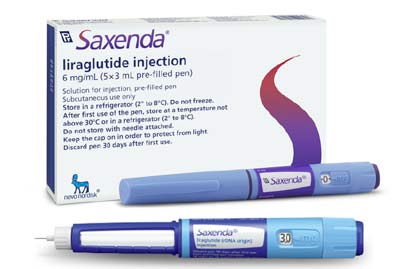
|
|
||||
SAXENDA contains liraglutide, an analog of human GLP-1 and acts as a GLP-1 receptor agonist. The peptide precursor of liraglutide, produced by a process that includes expression of recombinant DNA in Saccharomyces cerevisiae,
has been engineered to be 97% homologous to native human GLP-1 by substituting arginine for lysine at position 34. Liraglutide is made by attaching a C-16 fatty acid (palmitic acid) with a glutamic acid spacer on the remaining lysine
residue at position 26 of the peptide precursor.
 Dosage Forms and Strengths SAXENDA is a clear, colourless solution. Each 1 mL of SAXENDA solution contains 6 mg of liraglutide. Each pre-filled pen contains a 3 mL solution of SAXENDAŽ equivalent to 18 mg liraglutide (free-base, anhydrous). Usual dose: When you first start using SAXENDA, the starting dose is 0.6 mg once a day. Your dose should be increased after using SAXENDAŽ for one week until you reach the 3.0 mg dose. After that, do not change your dose unless your healthcare professional tells you to. SAXENDA is injected 1 time each day, at any time during the day. You can take SAXENDA with or without food. Your doctor should start you on a diet and exercise program when you start taking SAXENDA. Stay on this program while you are taking SAXENDA INDICATIONS AND CLINICAL USE SAXENDA (liraglutide) is indicated as an adjunct to a reduced calorie diet and increased physical activity for chronic weight management in adult patients with an initial body mass index (BMI) of: 30 kg/m2 or greater (obese), or 27 kg/m2 or greater (overweight) in the presence of at least one weight-related comorbidity (e.g., hypertension, type 2 diabetes, or dyslipidemia) and who have failed a previous weight management intervention.eased further to 1.8mg daily. DOSAGE FORMS, COMPOSITION AND PACKAGING SAXENDA is a solution for subcutaneous injection pre-filled, multi-dose pen that delivers doses of 0.6 mg, 1.2 mg, 1.8 mg, 2.4 mg, or 3.0 mg (6 mg/mL, 3 mL). SAXENDAŽ is available in the following package sizes containing disposable, pre-filled, multi-dose pens. 3 x SAXENDA 5 x SAXENDA POSSIBLE SIDE EFFECTS
SPECIAL HANDLING INSTRUCTIONS SAXENDA should be kept with the pen cap on when pen is not in use in order to protect from light. SAXENDA should be protected from excessive heat and sunlight. Always remove the injection needle after each injection and store the SAXENDA pen without an injection needle attached. This prevents contamination, infection, and leakage. It also ensures that the dosing is accurate. Storage: Do not use SAXENDA after the expiry date which is stated on the label and carton. The expiry date refers to the last day of that month. Before you start to use SAXENDA, store it in a refrigerator (2ºC to 8ºC) away from the freezer compartment. Do not freeze it. When SAXENDA is being used, you can keep it for 1 month either at room temperature (not above 30ºC) or in a refrigerator (2ºC to 8ºC). Do not use SAXENDA if it has been frozen. Do not use SAXENDA if it is not clear and colourless Always remove the injection needle after each injection and store your SAXENDA pen without an injection needle attached. This prevents contamination, infection, and leakage. It also ensures that the dosing is accurate. When you are not using the pen, keep the cap on. This will protect the medicine from light. Protect SAXENDA from high temperatures and sunlight. Medicines should not be disposed of via waste water or household waste. Ask your pharmacist how to dispose of medicines no longer required. These measures will help to protect the environment. Keep out of reach and sight of children. | ||||